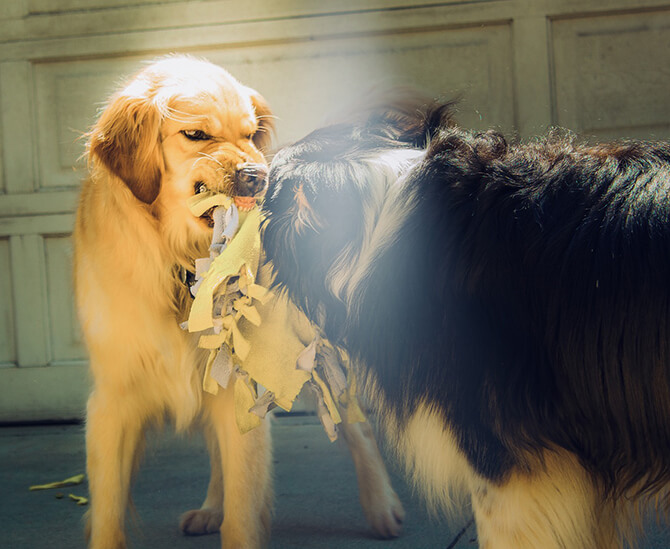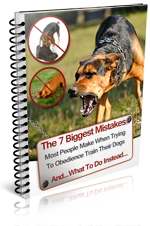When dealing with aggressive behavior in a dog, it helps if the owner can pinpoint what the cause of the aggressive behavior is in order to deal with it most effectively. You may wish to consider getting professional help - you can speak to your vet about a referral to a canine behavioral modification specialist.
Aggression is viewed completely differently by humans and dogs. To a dog, aggression isn't 'bad' or 'good', or even 'aggressive' in the sense that humans understand; it's merely a necessary reaction to a situation. But since dogs and humans use different communication systems, misunderstandings are likely to occur between the two species. For example, upon meeting a new dog, a common human reaction is to run straight up, make lots of loud enthusiastic noise ("OOOOOOOOH aren't you CUTE!") and attempt to pet them, often on the head. To humans, greeting a dog like this is second nature; but if a dog acted this way towards another dog, especially upon meeting for the first time, it would be counted as a deliberate show of aggression.
The responsibility lies with humans to understand how dogs communicate, and how to train and condition your dog so that he understands that aggressive behavior is unnecessary and not to be tolerated.
Types of Aggressive Dog Behaviors
Listed below are some of the more common causes for aggressive behavior in dogs:
- Fear-based aggression is a defensive reaction to a threatening situation: your dog is reacting in self-defense because he senses a threat. For example, if you back your dog into a corner while loudly telling him off about something, he'll feel boxed in and threatened, and may conclude that to prevent you from doing harm he must react with aggression.
- Redirected aggression. You can think of this in human terms like this: say your spouse comes home from work in a foul temper. He's had a terrible day. Is this your fault? No, not at all - but he still takes out his bad mood on you. Some dogs behave in similar ways sometimes: if you've stopped him from behaving aggressively towards, say, another dog, he might redirect that aggression towards another, unrelated source.
- Dominance aggression occurs when your dog thinks he is the leader of the household. This generally occurs when owners don't understand how dogs communicate, and so hasn't paid attention to the series of increasingly dominant behaviors that their dogs have demonstrated. The end result is generally your dog concluding that he is, in fact, the pack leader, since you're demonstrably not; and if you do anything to threaten this position, he'll defend it appropriately.
- Territorial aggression: for example, food-guarding (your dog may react aggressively if you approach while he's eating), toy-guarding, or furniture-guarding (for example, he may snarl at you if you attempt to dislodge him from a comfy position on the couch). These are all signals that your dog considers himself to be ranked higher than you in the household hierarchy.
- Pain-based aggression. If you handle your dog when he's in pain - for example, if he's been hit by a car, or has injured himself somehow - then he'll probably react aggressively: either because you're hurting him, or because he's afraid you're going to.
- Maternal aggression. Some bitches are proud of their achievement in producing a litter of pups, and are quite happy to have trusted people go near and pick them up; others are intensely protective and will warn you away with signs of aggression if you come within a few feet.
| Got An Aggressive Dog? Did you know that incorrect Dog Aggression Training can Ruin your Dog - Learn More | Secrets to Dog Training - Dog Training See what the world's most popular Dog Training Guide can do for your Dog. |
Dealing with aggression isn't particularly difficult, provided you know exactly what you're doing. This is very important: inexperienced or ignorant people who attempt to correct aggressive behavior are effectively playing with a loaded gun. It's important that you do your homework on dog psychology and communication, and preventing and treating problem behaviors like aggression Click here for Aggressive Dog Training Guide.
It bears repeating that you MUST KNOW WHAT YOU'RE DOING if you want to treat aggressive behavior yourself. You neet to be able to figure out why he's behaving that way, and take quick efficient steps to treat it. It is no good trying to correct the behavior by shouting and telling him off if he acts in a certain way; different types of aggression require different approaches. Often aggressive behavior is merely a symptom of a deeper problem that your dog has which will also need to be diagnosed and treated accordingly.


